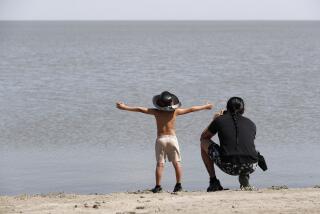Dry Lake Gives Clue to Life on Prehistoric Grasslands
- Share via
LUBBOCK, Tex. — When the natural springs that had fed this West Texas region for millennia dried up in the 1930s, Lake Lubbock vanished with them.
But the lake has not been forgotten. Its legacy was in helping to preserve a treasure store of artifacts of human and animal life dating back more than 11,000 years, archeologists say.
The arid, wind-swept plains of West Texas were once rich grasslands that supported hairy mammoths, 3-foot-tall armadillos and bears three times the size of a grizzly. Lake Lubbock has provided the proof of this past.
A 300-acre site northwest of Lubbock, where the lake once existed, has been turned into a state park and also designated a federal historic site. The Lake Lubbock Landmark opened this month.
Some archeologists regard it as the premier site of its kind in North America. Over the last 50 years, researchers have unearthed evidence that the area has been continuously inhabited for more than 11,000 years.
“The site, basically, is little packages of time stacked one on top of the other,” said Eileen Johnson, the park’s director. “You can study man’s entire existence in the New World in one spot, instead of having to go to 100 different sites.”
From fossils excavated at the site, researchers have been able to identify soils, vegetation, pollen records, wildlife and human cultures.
Among the important finds have been an ancient short-faced bear, a giant armadillo and mammoths.
“The giant armadillo was truly Texas-size,” Johnson said. “It was 3 feet tall and 6 feet long.”
Researchers have also identified the remains of prehistoric plants, fish, amphibians, reptiles and birds, she said.
They have found evidence of human habitation--projectile points, bone tools, manufacturing debris, processing areas, slaughter sites and an oven--but, “the most fantastic thing is that no human remains have ever been found,” said Robert A. Nash, a longtime supporter and namesake of the landmark’s interpretive center.
“That would be the find of the century--if they found a skull of the so-called Clovis or Folsom man,” he said.
The site includes a museum and a research lab occupied by archeological students from Texas Tech University.
After visitors pass through the museum, filled with murals of ancient life, photographs and fossils, they are encouraged to walk through the digs. Picnic tables and grills are set up for barbecues.
The park is a collaborative effort of the Texas Parks and Wildlife Department, Texas Tech and the City of Lubbock. The state agency leases the property from the city and Texas Tech conducts the research.
“We know only 5% of what is out there,” Johnson said. “It’s awe-inspiring and exciting to think we will be uncovering and learning here for years and years to come.”
John Albanese, a Wyoming-based geologist and independent consultant for archeological sites, said the park “is the premier site in terms of the quality and quantity of the old material that has been found there.”
“It’s one of the better preserved records of early man in North America,” he said.
More to Read
Sign up for Essential California
The most important California stories and recommendations in your inbox every morning.
You may occasionally receive promotional content from the Los Angeles Times.











